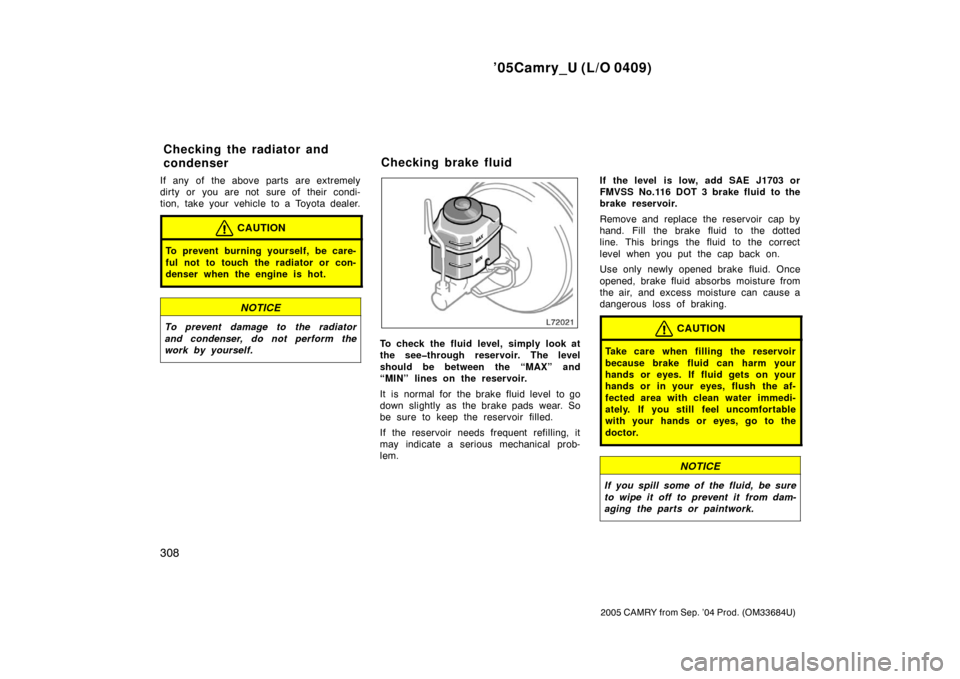Page 259 of 352

’05Camry_U (L/O 0409)
251
2005 CAMRY from Sep. ’04 Prod. (OM33684U)
HITCHES
�Use only a hitch which is recom-
mended by the hitch manufacturer and
conforms to the total trailer weight re-
quirement.
�Follow the directions supplied by the
hitch manufacturer. Lubricate the hitch
ball with a light coat of grease.
�Toyota recommends removing the trail-
er hitch whenever you are not towing
a trailer to reduce the possibility of
additional damage caused by the hitch
if your vehicle is struck from behind.
NOTICE
Do not use axle�mounted hitches as
they can cause damage to the axle
housing, wheel bearings, wheels or
tires. Also, never install a hitch which
may interfere with the normal function
of an Energy Absorbing Bumper, if so
equipped.
BRAKES AND SAFETY CHAINS
�Toyota recommends trailers with
brakes that conform to any applica-
ble federal and state/provincial regu-
lations.
�A safety chain must always be used
between the towing vehicle and the
trailer. Leave sufficient slack in the
chain for turns. The chain should
cross under the trailer tongue to
prevent the tongue from dropping to
the ground in case it becomes dam-
aged or separated. For correct safety
chain procedures, follow the hitch or
trailer manufacturer ’s recommenda-
tions.
CAUTION
�If the total trailer weight exceeds
453 kg (1000 lb.), trailer brakes are
required.
�Never tap into your vehicle’s hy-
draulic system as it would lower its
braking effectiveness.
�Never tow a trailer without using a
safety chain securely attached to
both the trailer and the vehicle. If
damage occurs to the coupling unit
or hitch ball, there is danger of the
trailer wandering over into another
lane.
TIRES
�Ensure that your vehicle’s tires are
properly inflated. Adjust the tire pres-
sure to the recommended cold tire
pressure indicated below (see page
309 in Section 7−2 and page 334 in
Section 8 for instructions.):
Tire pressure, kPa (kgf/cm
2 or bar, psi)
P205/65R15 92T or 92H Front 220 (2.2, 32)
Rear 220 (2.2, 32)
P215/60R16 94V Front 200 (2.0, 29)
Rear 200 (2.0, 29)
P215/55R17 93V Front 220 (2.2, 32)
Rear 220 (2.2, 32)
�The trailer tires should be inflated to
the pressure recommended by the trail-
er manufacturer in respect to the total
trailer weight.
Page 261 of 352

’05Camry_U (L/O 0409)
253
2005 CAMRY from Sep. ’04 Prod. (OM33684U)
�Avoid jerky steering and sharp turns.
The trailer could hit your vehicle in a
tight turn. Slow down before making a
turn to avoid the necessity of sudden
braking.
�Remember that when making a turn,
the trailer wheels will be closer than
the vehicle wheels to the inside of the
turn. Therefore, compensate for this by
making a larger than normal turning
radius with your vehicle.
�Crosswinds and rough roads will ad-
versely affect handling of your vehicle
and trailer, causing sway. Pay attention
to the rear from time to time to pre-
pare yourself for being passed by large
trucks or buses, which may cause your
vehicle and trailer to sway. If swaying
happens, firmly grip the steering wheel
and reduce speed immediately but
gradually. Never increase speed. Steer
straight ahead. If you make no extreme
correction with the steering or brakes,
the vehicle and trailer will stabilize.
�Be careful when passing other ve-
hicles. Passing requires considerable
distance. After passing a vehicle, do
not forget the length of your trailer and
be sure you have plenty of room be-
fore changing lanes.
�In order to maintain engine braking effi-
ciency do not use overdrive (automatic
transmission) or fifth gear (manual
transmission).
�Because of the added load of the trail-
er, your vehicle’s engine may overheat
on hot days (at temperatures over
30�C [85 �F]) when going up a long or
steep grade with a trailer. If the engine
coolant temperature gauge indicates
overheating, immediately turn off the air
conditioning (if in use), pull off the road
and stop in a safe spot. Refer to “If
your vehicle overheats” on page 262 in
Section 4.
�Always place wheel blocks under both
the vehicle and trailer wheels when
parking. Apply the parking brake firmly.
Put the transmission in “P” (automatic)
or in first or reverse (manual). Avoid
parking on a slope with a trailer, but
if it cannot be avoided, do so only
after performing the following: 1. Apply the brakes and hold.
2. Have someone place wheel blocks un-
der both the vehicle and trailer wheels.
3. When the wheel blocks are in place, release your brakes slowly until the
blocks absorb the load.
4. Apply the parking brake firmly.
5. Shift into “P” (automatic) or first or reverse (manual) and turn off the en-
gine.
When restarting out after parking on a
slope: 1. With the transmission in “P” position (automatic) or the clutch pedal de-
pressed (manual), start the engine.
(With an automatic transmission, be
sure to keep the brake pedal de-
pressed.)
2. Shift into gear.
3. Release the parking brake (also foot brake on automatic transmission ve-
hicles) and slowly pull or back away
from the wheel blo cks. Stop and apply
your brakes.
4. Have someone retrieve the blo cks.
Page 316 of 352

’05Camry_U (L/O 0409)
308
2005 CAMRY from Sep. ’04 Prod. (OM33684U)
If any of the above parts are extremely
dirty or you are not sure of their condi-
tion, take your vehicle to a Toyota dealer.
CAUTION
To prevent burning yourself, be care-
ful not to touch the radiator or con-
denser when the engine is hot.
NOTICE
To prevent damage to the radiator
and condenser, do not perform the
work by yourself.
To check the fluid level, simply look at
the see�through reservoir. The level
should be between the “MAX” and
“MIN” lines on the reservoir.
It is normal for the brake fluid level to go
down slightly as the brake pads wear. So
be sure to keep the reservoir filled.
If the reservoir needs frequent refilling, it
may indicate a serious mechanical prob-
lem. If the level is low, add SAE J1703 or
FMVSS No.116 DOT 3 brake fluid to the
brake reservoir.
Remove and replace the reservoir cap by
hand. Fill the brake fluid to the dotted
line. This brings the fluid to the correct
level when you put the cap back on.
Use only newly opened brake fluid. Once
opened, brake fluid absorbs moisture from
the air, and excess moisture can cause a
dangerous loss of braking.
CAUTION
Take care when filling the r
eservoir
because brake fluid can harm your
hands or eyes. If fluid gets on your
hands or in your eyes, flush the af-
fected area with clean water immedi-
ately. If you still feel uncomfortable
with your hands or eyes, go to the
doctor.
NOTICE
If you spill some of the fluid, be sure
to wipe it off to prevent it from dam-
aging the parts or paintwork.
Checking the radiator and
condenser Checking brake fluid
Page 346 of 352

’05Camry_U (L/O 0409)
338
2005 CAMRY from Sep. ’04 Prod. (OM33684U)
Fuses (type B)
52. MAIN 40 A: “HEAD LH LWR”, “HEAD
RH LWR”, “HEAD LH UPR”, “HEAD LH
UPR” and “DRL” fuses
53. ABS No.2 40 A: Anti−lock brake sys-
tem, vehicle stability control system,
traction control system, brake assist
system
54. RDI 30 A: Electric cooling fan
55. CDS 30 A: Electric cooling fan
56. HTR 50 A: Air conditioning system
57. ADJ PDL 30 A: Power adjustable ped-
als
58. ABS No.3 30 A: Anti−lock brake sys-
tem, vehicle stability control system,
traction control system, brake assist
system
59. PWR SEAT 30 A: Power seats
60. PWR NO.1 30 A: Driver ’s door lock
system, driver’s power wi ndow, electric
moon roof
61. DEF 40 A: Rear window defogger Fuses (type C)
62. ALT 120 A: “DEF”, “PWR NO.1”, “PWR
NO.2”, “PWR NO.3”, “PWR NO.4”,
“STOP”, “DOOR NO.2”, “OBD”, “PWR
SEAT”, “FUEL OPEN”, “FOG”, “AMP”,
“PANEL”, “TAIL”, “AM1”, “CIG”, “POW-
ER POINT”, “RAD NO.2”, “ECU −ACC”,
“GAUGE1”, “GAUGE2”, “ECU −IG”,
“WIPER”, “WASHER”, “HTR (10 A)”,
“SEAT HTR” and “SUN −SHADE” fuses
63. ABS NO.1 50 A: Anti−lock brake sys-
tem, vehicle stability control system,
traction control system, brake assist
system